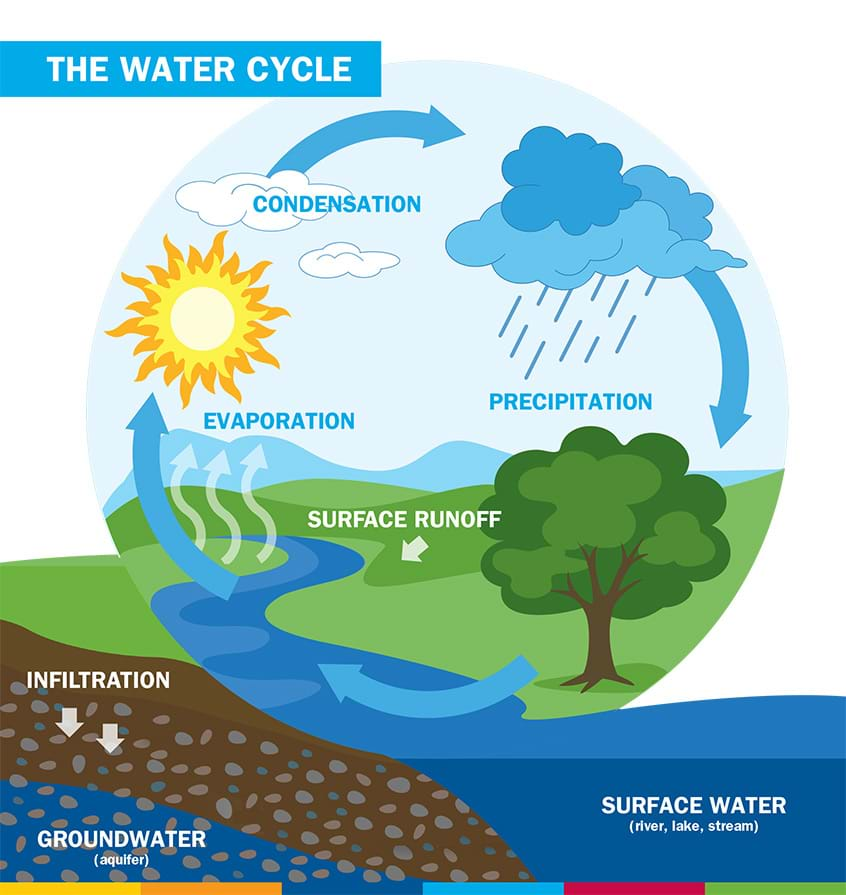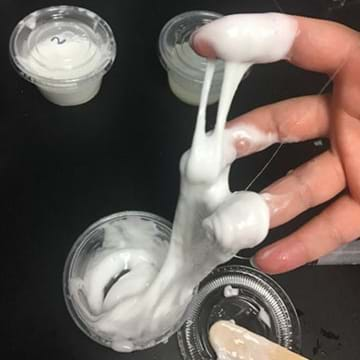
Water and Dams in Today's World Elementary School Lesson
Students learn about the importance of dams by watching a video that presents historical and current information on dams, as well as descriptions of global water resources and the hydrologic cycle. Students also learn about different types of dams, all designed to resist the forces on dams. (If the free, 15-minute "Water and Dams in Today's World" video cannot be obtained in time, the lesson can still be taught. See the Additional Multimedia Support section for how to obtain the DVD or VHS videotape, or a PowerPoint presentation with similar content [also attached].)

Water Cycle Elementary School CurricularUnit
Water is essential to life. Understanding how the water cycle works, the importance of water as a natural resource, and how our household water cycle functions is essential knowledge for everyone. Through a range of water-based explorations and the engineering design process, students learn about the water cycle and how engineers manage it.

Wind Power! Designing a Wind Turbine Elementary School Activity
Students learn how engineers transform wind energy into electrical energy by building their own miniature wind turbines and measuring the electrical current they produce. They explore how design and position affect the electrical energy production.

Floodplain Modeling Middle School Activity
Students explore the impact of changing river volumes and different floodplain terrain in experimental trials with table top-sized riverbed models. The models are made using modeling clay in aluminum baking pans placed on a slight incline. Water added "upstream" at different flow rates and to different riverbed configurations simulates different potential flood conditions. Students study flood dynamics as they modify the riverbed with blockages or levees to simulate real-world scenarios.

Lunar Lollipops: Reproducing the Moon Phases Elementary School Activity
Students work in teams of two to discover the relative positions of the Earth, Sun and Moon that produce the different phases of the Moon. Groups are each given a Styrofoam ball that they attach to a pencil so that it looks like a lollipop. In this acting-out model exercise, this ball on a stick represents the Moon, the students represent the Earth and a hanging lightbulb serves as the Sun. Students move the "Moon" around them to discover the different phases. They fill in the position of the Moon and its corresponding phase in a worksheet.

Python Script Analysis High School Activity
Working in small groups, students complete and run functioning Python codes. They begin by determining the missing commands in a sample piece of Python code that doubles all the elements of a given input and sums the resulting values. Then students modify more advanced Python code, which numerically computes the slope of a tangent line by finding the slopes of progressively closer secant lines; to this code they add explanatory comments to describe the function of each line of code. This requires students to understand the logic employed in the Python code. Finally, students make modifications to the code in order to find the slopes of tangents to a variety of functions.

Super Slime Engineering Elementary School Activity
Who can engineer the best slime? Beginning with a preset recipe, students make slime, observe it, and then decide on what and how they want to improve it, such as making it stickier or less sticky. Students then make their updated slime by implementing the changes they want to make. They are introduced to product optimization, material science and polymer engineering.

Spaghetti Bridges Middle School Activity
Civil engineers design structures such as buildings, dams, highways and bridges. Student teams explore the field of engineering by making bridges using spaghetti as their primary building material. Then they test their bridges to see how much weight they can carry before breaking.

Designing Bridges Middle School Lesson
Students learn about the types of possible loads, how to calculate ultimate load combinations, and investigate the different sizes for the beams (girders) and columns (piers) of simple bridge design. They learn the steps that engineers use to design bridges by conducting their own hands on associated activity to prototype their own structure. Students will begin to understand the problem, and learn how to determine the potential bridge loads, calculate the highest possible load, and calculate the amount of material needed to resist the loads.

Waterwheel Work: Energy Transformations and Rotational Rates Elementary School Activity
Students learn the history of the waterwheel and common uses for water turbines today. They explore kinetic energy by creating their own experimental waterwheel from a two-liter plastic bottle. They investigate the transformations of energy involved in turning the blades of a hydro-turbine into work, and experiment with how weight affects the rotational rate of the waterwheel. Students also discuss and explore the characteristics of hydroelectric plants.

The Dirty Water Project: Design-Build-Test Your Own Water Filters Elementary School Activity
In this hands-on activity, students investigate different methods—aeration and filtering—for removing pollutants from water. Working in teams, they design, build and test their own water filters—essentially conducting their own "dirty water projects." A guiding data collection worksheet is provided.

What Is Energy? Elementary School Lesson
With an introduction to the ideas of energy, students discuss specific energy types and practical energy sources. Associated hands-on activities help them identify energy types in their surroundings and enhance their understanding of the concept of energy.

Right on Target: Catapult Game Elementary School Activity
Students experience the engineering design process as they design and build accurate and precise catapults using common materials. They use their catapults to participate in a game in which they launch Ping-Pong balls to attempt to hit various targets.

Wind-Powered Sail Cars Elementary School Activity
Student pairs design and construct small, wind-powered sail cars using limited quantities of drinking straws, masking tape, paper and beads. Teams compete to see which sail car travels the farthest when pushed by the wind (simulated by the use of an electric fan). Students learn about wind and kinetic and renewable energy, and follow the seven steps of the engineering design process to ask, research, imagine, plan, create, test, and improve their sail cars. This activity is part of a unit in which multiple activities are brought together for an all-day school/multi-school concluding “engineering field day” competition.

Bulbs & Batteries in a Row Elementary School Activity
Using the science and engineering practice of making observations, we can explore the phenomenon of energy transfer. Every day, we are surrounded by circuits that use “in parallel” and “in series” circuitry. Complicated circuits designed by engineers are composed of many simpler parallel and series circuits, but both kinds of circuits transfer energy. During this activity, students make sense of the phenomenon of energy transfer as they build a simple series circuit and discover the properties associated with series circuits. Through this, students engage with the disciplinary core idea that energy can be transferred from place to place by electric currents.
Last updated 18 hour(s) ago


